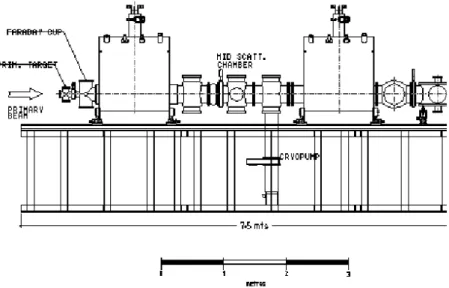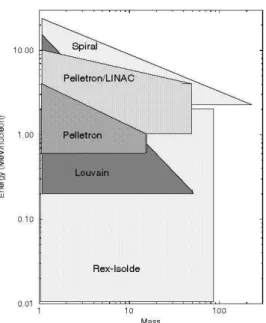294 Brazilian Journal of Physics, vol. 33, no. 2, June, 2003
Radioactive Ion beams in Brasil (RIBRAS)
∗
R. Lichtenth¨aler, A. L´epine-Szily, V. Guimar˜aes, G.F. Lima, and M.S. Hussein
Departamento de F´ısica Nuclear
Instituto de F´ısica da Universidade de S˜ao Paulo
CP 66318, 05315-970 S˜ao Paulo SP, Brasil
Received on 30 October, 2002
The study of the so called exotic nuclei constitutes an important field of research in nuclear physics. The pos-sibility of producing secondary beams of unstable nuclei(RIB) allows the investigation of nuclei at extreme conditions as low binding energies, high angular momentum and isospin. More laboratories are going through the process of re-direction of their experimental effort towards this activity. The nuclear physics community in Brazil has enthusiastically decided to join this endeavor to provide the Pelletron/LINAC complex with two superconducting solenoids which will permit the production of secondary beams of radioactive nuclei. A de-scription of this facility and project RIBRAS follows.
I
The RIBRAS project
The Pelletron-LINAC Laboratory of the University os S˜ao Pulo is working on the installation of the first of the first South America Radioactive Ion beam device (RIBRAS) [1, 3]. This facility extends the capabilities of the original Pelletron accelerator by producing secondary beams of un-stable nuclei. A drawing of this system is shown in Figure 1. The most important components in this system are the two new super-conducting solenoids.
The solenoids have 6.5 T maximum central field (5 T.m axial field integral) and a 30 cm clear warm bore, which corresponds to an angular acceptance in the range (2 ≤
θ ≤ 15 deg). The system was conceived by Cryomagnet-ics INC and it was designed to operate following the Linac post-accelerator of maximum energy of 10 MeV.A presently under installation. This energy will be about3times larger than the maximum energy of the present Pelletron Tandem of8MV terminal voltage (3-5MeV.A).
The liquid He consumption of these solenoids is about 0.14 l/hr in persistent mode, and 0.7 l/hr with an exter-nal current of 90 A at maximum magnetic field. Both of these are compatible with the capability of the He liquifier installed at Pelletron-LINAC Laboratory. The presence of the two magnets in the design is very important. The first solenoid makes an in-flight selection of the reaction prod-ucts emerging from the primary target in the forward angle region. As the first magnet transmits all ions with the same magnetic rigiditymE/Q2
the radioactive secondary beam can be rather poor. With two solenoids, it is possible to use differential energy loss in an energy degrader foil, located at the crossover point between the magnets. This degrader foil will allow the second solenoid to select the ion of interest by moving the contaminant ions out of its bandpass. Time
of flight technique using pulsed primary beam is also very useful in order to identify nuclei of interest in the secondary beam. The buncher system to be used in the Pelletron accel-erator to pulse the beam is presently being installed.
An additional future possibility of the two solenoid system is the production of tertiary beams using a sec-ondary target in the middle scattering chamber. The second solenoid can be tuned to select a different magnetic rigidity producing low intensity (1-100/s) tertiary beams like 9Li, 8
He.[3] This is in principle possible with secondary beams of 107
/s and assuming a tipically conversion efficiency of 10−5for the secondary reaction. In order to achieve higher secondary beam intensities one possibility for the future is the installation of an ECR ion source before the LINAC.
II
The Physics with RIBRAS
The two solenoids are presently installed in the 45B Pel-letron beam line. It should be noted that setting up the solenoid system prior to the completion of the LINAC post-accelerator is an important consideration. This will make possible to begin experiments with a facility that is in prin-ciple similar to the TWINSOL at Notre Dame University [2]. In this first stage with the Pelletron primary beam, the Pelletron primary beam of7,6Liof 3-5 MeV.A and 1-2µAe,
will permit the production of secondary beams such as7Be, 8
B,8Li,6Heof intensities around104to106particles per second. With these intensities one can perform measure-ments of elastic scattering angular distributions and stud-ies of the interaction potential of systems involving exotic projectiles allowing the investigation of phenomena such as proton and neutron halo in nuclei. The possibility of studies of the scattering of secondary beams of nuclei in isomeric excited states is also a new interesting subject.
R. Lichtenth¨aleret al. 295
Figure 1. Scale illustration of the S˜ao Paulo - double solenoid ion-optical RIB system, RIBRAS.
Another interesting problem that can be investigated is the fusion involving nuclei near to the drip lines. It is ex-pected that neutron and proton halo projetiles would have different behaviors in the fusion process with heavy targets below the Coulomb barrier due to the different characteris-tics of the halo. Measurements of fusion cross-sections in-volving such exotic projectiles will be in principle possible in the first stage of RIBRAS.
Probably the most important impact of the research with RIB is in nuclear astrophysics [4]. The possibility of mea-suring the cross-sections of capture reactions of astrophys-ical interest involving exotic nuclei will certainly have im-portant consequences in the models of the primordial as well as in the explosive nucleosynthesis. Measurements of cap-ture reactions near to the proton and neutron drip lines are of crucial importance in the rp-process and r-process responsi-ble for the nucleosynthesis of heavy elements.
Figure 2. The reaction chain to11Bin the primordial nucleosyn-thesis, ref.5.
On the other hand, the primordial nucleosynthesis
in-volves reactions with light nuclei that would be accessible with RIBRAS beams. In Fig. 2 is shown the reaction chain to11
Bin the inhomegenous model of primordial nucleosyn-thesis [5]. There are new paths near to the neutron drip line involving nuclei like8Li,6Hethat would lead to11B. The group of researchers responsible for the installation of the two solenoid system is mainly interested in elastic scattering and fusion measurements with exotic beams and in transfer reactions of astrophysical interest.
The proposed RIBRAS facility will have several important advantages provided by the linear post-accelerator(LINAC). In particular, higher-energy (up to 10 MeV/nucleon), higher mass (perhaps up to A = 50) ra-dioactive ion beams can be produced with beam purities approaching 80% in many cases. In addition, the pulsed time structure of the beam will provide a time-of-flight pa-rameter that can be used to reduce backgrounds in many experiments. On a more speculative note, if Uranium beams could be accelerated to energies of a few MeV per nucleon, transfer induced fission reactions could be used to produce a wide variety of very neutron rich fission fragments. The beams formed in this way are not likely to be very pure, but they could be useful in a number of experiments. How-ever, this extended project would require the installation of a low-βinitial acceleration stage and an ECR source at the LINAC, and possibly even the addition of more resonators to increase the energy of the primary beam. Recent devel-opments of ECR ion sources allow the production of stable beams of very high intensities, which compensates the low production rate due to the thin primary target in the in-flight method. The increase of a few hundreds of Watts in the LINAC primary beam seems to be possible and would in-crease considerably the range of secondary beams that can be produced in RIBRAS.
296 Brazilian Journal of Physics, vol. 33, no. 2, June, 2003
Figure 3. The regions in terms of mass and energy of operations of several RIB facilities.
III
Recent Developments
The two 6.5 Tesla solenoids are already mounted on the 7.5m length aluminum support in the 45B beam line of the Pelletron Laboratory. Both solenoids were bench tested suc-cessfully on April, 2002. The magnets were cooled down to liquid helium temperature 4K and charged up to currents of 80 Amperes (magnet 2) and 50 Amperes (magnet 1). The components of the beam line for the two solenoids including primary target, Faraday cup and mid scattering ISO cham-bers are in the stage of installation. The Faraday cup and primary target are being manufactured. The secondary scat-tering chamber is being projected and will probably be
man-ufactured at the Laborat´orio Nacional de Luz Syncrotron (LNLS), Campinas, S˜ao Paulo, Brazil.
IV
Conclusions
A double superconducting 6.5T(5T.m) solenoid system is being installed at the Pelletron-LINAC Laboratory of the University of S˜ao Paulo in order to produce secondary beams of radioactive nuclei. The two solenoids are mounted and tested on the 45B beam line of the Pelletron experimen-tal area. The beam line is being insexperimen-talled. The system shall begin its operation using the primary beams of the 8MV Pel-letron Tandem and will be moved to the 10 MeV/nucleon LINAC post-Accelerator as soon as it starts operating.
References
[1] “Proposal for the Ribras project”, M.S. Hussein, A. L´epine-Szily, R. Lichtenth¨aler Filho, A.C.C. Villari, and V. Guimar˜aes, (1997); Nuclear Physics Department, Annual Report 1998.
[2] “A Radioactive Beam Facility using a Large Superconduct-ing Solenoid”, J. J. Kolata, F. D. Becchetti, W. Z. Liu, D. A. Roberts, and J. W. Janecke, Nucl. Instrum. Meth. B40/41, 503 (1989).
[3] F.D. Bechetti, J.A. Brown, K. Ashktorab, J.W. J¨anecke, W.Z. Liu, D.A. Roberts, R.J. Smith, J.J. Kolata, K. amkin, A. Mor-sad, and R.E. Warner Nucl. Instrum. and Methods in Phys. Res. B56/57, 554 (1991).
[4] S. Kubono; Nucl. Phys. A693, 221 (2001).
[5] P.D. Zecher, A. Galonsky, S.J. Gaff, J.J. Kruse, G. Kunde, E. Tryggestad, J. Wang, R.E Warner, D.J. Morrissey, K. Ieki, Y. Iwata, F. De´ak, ´A. Horv´ath, A. Kiss, Z. Seres, J.J. Kolata, J. von Schwarzenberg, and H. Schelin Phys. ReV.C57, 959 (1998).

